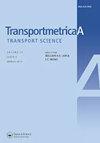考虑拥挤的公交系统最优车辆容量与调度策略
IF 3.1
2区 工程技术
Q2 TRANSPORTATION
引用次数: 0
摘要
本研究调查了公共交通系统中经常被忽视的上车拥挤对运营和用户成本的影响,特别是在具有不同需求模式的多对多公交线路中。虽然以前的研究使用数学规划来解决类似的问题,但本文采用分析方法来提供更深入的见解并解决基本问题。首先,我们提出了一种方法来确定最优公交容量,考虑到车内拥挤成本,假设车头距固定。其次,在考虑拥挤成本的情况下,探讨了固定容量公交的最优调度策略。三是同步优化车头时距和车辆容量。研究结果表明,最优车辆容量与乘客平均行程长度和拥挤不适成本的平方根相关,特别是当拥挤程度随载客量线性增加时。当车头距和容量都是可变的时候,车头距较短的小型车辆更受青睐,尤其是在需求适中的情况下,尤其是在自动驾驶车队等具有成本效益的员工模式下。本文章由计算机程序翻译,如有差异,请以英文原文为准。
Optimal vehicle capacity and dispatching policy considering crowding in public bus transit services
This study investigates the often overlooked impact of on-board crowding on operational and user costs in public transit systems, specifically within a many-to-many bus transit line with varying demand patterns. While previous research has used mathematical programming for similar problems, this paper employs analytical approaches to offer deeper insights and address fundamental questions. First, we propose an approach to determine optimal bus capacities, factoring in in-vehicle crowding costs, assuming a fixed headway. Second, we explore the optimal dispatching policy for buses with fixed capacities, considering crowding costs. Third, we optimize both headway and vehicle capacity simultaneously. Our findings reveal that optimal vehicle capacity correlates with average passenger trip length and the square root of crowding-discomfort costs, especially when crowding increases linearly with load factor. When both headway and capacity are variable, smaller vehicles with shorter headways are favored, particularly in moderate-demand scenarios, especially with cost-effective staff models like autonomous fleets.
求助全文
通过发布文献求助,成功后即可免费获取论文全文。
去求助
来源期刊

Transportmetrica A-Transport Science
TRANSPORTATION SCIENCE & TECHNOLOGY-
CiteScore
8.10
自引率
12.10%
发文量
55
期刊介绍:
Transportmetrica A provides a forum for original discourse in transport science. The international journal''s focus is on the scientific approach to transport research methodology and empirical analysis of moving people and goods. Papers related to all aspects of transportation are welcome. A rigorous peer review that involves editor screening and anonymous refereeing for submitted articles facilitates quality output.
 求助内容:
求助内容: 应助结果提醒方式:
应助结果提醒方式:


